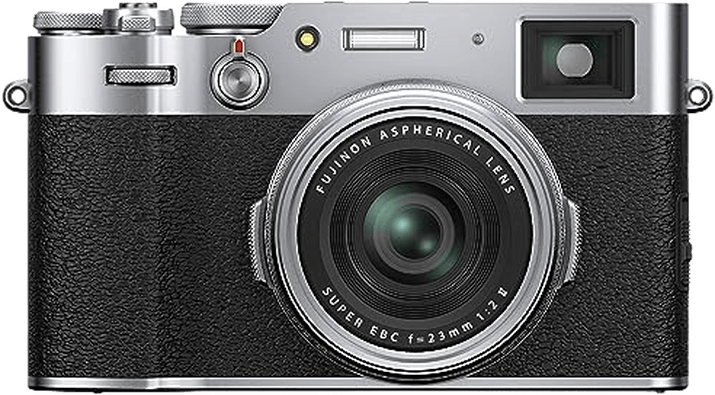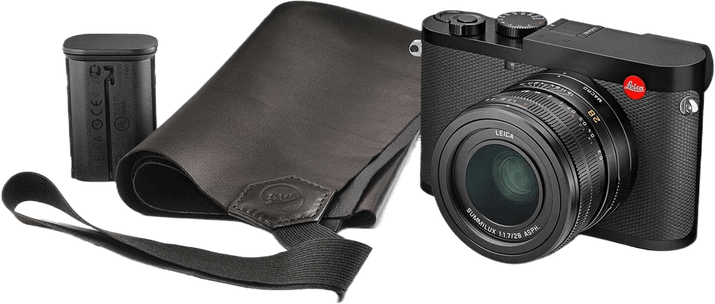Fujifilm X100V vs Leica Q2 Comparison
Fujifilm X100V

Leica Q2

The Leica Q2 emerges as the winner with a score of 76/100, while the Fujifilm X100V trails behind at 69/100. Both cameras were released in 2019 and 2020, respectively, and share similarities in their release years and camera types – Leica being a compact camera and Fujifilm a mirrorless one.
The Leica Q2 boasts a higher score due to its superior performance and quality. Despite its higher launch price of $5000, the camera justifies its cost with top-notch features and functionality. On the other hand, the Fujifilm X100V is more affordable at $1399, making it a more budget-friendly option.
In terms of size and weight, the Fujifilm X100V is the lightweight champ, weighing in at 478g and measuring 128 x 75 x 53mm. The Leica Q2 is heavier at 734g and slightly larger with dimensions of 130 x 80 x 92mm. This makes the Fujifilm X100V more portable and convenient for on-the-go photography.
Considering the scores, specifications, and prices, the Leica Q2 is the better camera for those who prioritize performance and quality, while the Fujifilm X100V is a more cost-effective and portable option for photography enthusiasts.
Fujifilm X100V vs Leica Q2 Overview and Optics
The Leica Q2 outperforms the Fujifilm X100V in optics with a score of 79/100 compared to the Fujifilm’s 66/100. Both cameras share some common specifications, such as a CMOS sensor, fixed lens mount, and lack of image stabilization. However, there are notable differences that contribute to the Leica Q2’s higher score.
The Leica Q2 boasts a 47.3-megapixel sensor, significantly higher than the Fujifilm X100V’s 26-megapixel sensor, which results in sharper and more detailed images. Moreover, the Leica Q2 features a full-frame sensor, compared to the Fujifilm X100V’s APS-C sensor. The full-frame sensor provides better low-light performance, dynamic range, and depth of field control. Additionally, the Leica Q2 has a DXOMARK score of 96 for its sensor, further establishing its superior image quality.
On the other hand, the Fujifilm X100V has a slightly faster shooting speed of 11 frames per second, compared to the Leica Q2’s 10 frames per second. This advantage is minimal and may not significantly impact the overall shooting experience. The Fujifilm X100V also uses the X-Processor 4, which is a powerful processor, but it is difficult to compare directly with the Leica Q2’s Maestro II processor.
In terms of optics, the Leica Q2 clearly surpasses the Fujifilm X100V with its higher megapixel count, full-frame sensor, and excellent DXOMARK score. While the Fujifilm X100V has a marginally faster shooting speed, it does not make up for the difference in image quality. Therefore, the Leica Q2 is the superior choice for photographers who prioritize optical performance.
Fujifilm X100V vs Leica Q2 Video Performance
The Fujifilm X100V and the Leica Q2 have identical video scores of 91/100, indicating that both cameras excel in video performance. Both cameras share key video specifications, such as a maximum video resolution of 4K, video dimensions of 4096 x 2160, a maximum video frame rate of 120fps, and built-in time-lapse functionality.
The Fujifilm X100V offers impressive video capabilities, delivering high-quality 4K video with crisp details and vivid colors. Its maximum frame rate of 120fps allows for smooth slow-motion footage, while the built-in time-lapse functionality enables the creation of stunning time-lapse sequences. The X100V is a strong choice for videographers seeking a powerful yet compact camera.
Similarly, the Leica Q2 also boasts remarkable video performance, with 4K video resolution and 120fps frame rate. The Q2’s time-lapse functionality adds versatility to its video capabilities, making it a solid option for those interested in capturing both stills and video.
Despite their identical scores, each camera has unique strengths that may appeal to different users. The Fujifilm X100V is known for its compact size and user-friendly interface, making it an excellent choice for on-the-go videographers. On the other hand, the Leica Q2 offers a premium build quality and the renowned Leica brand, which may attract enthusiasts and professionals seeking a high-end camera with exceptional video capabilities.
When comparing the Fujifilm X100V and the Leica Q2, both cameras provide outstanding video performance with similar specifications. The choice between the two ultimately depends on individual preferences and priorities, such as size, interface, and brand reputation.
Fujifilm X100V vs Leica Q2 Features and Benefits
The Fujifilm X100V outperforms the Leica Q2 in features with a score of 85/100 compared to the Leica Q2’s 83/100. Both cameras share several specifications, including a 3-inch touchscreen, GPS absence, and connectivity options such as WIFI and Bluetooth.
The Fujifilm X100V excels with its higher screen resolution of 1,620,000 dots compared to the Leica Q2’s 1,040,000 dots. This difference ensures a clearer and more detailed display on the X100V. Additionally, the X100V offers a flip screen, providing flexibility in shooting angles and enhancing the user experience.
On the other hand, the Leica Q2 does not surpass the Fujifilm X100V in any specific feature. However, it maintains a close score, indicating that it is still a strong contender in terms of overall features.
Considering the points mentioned above, the Fujifilm X100V holds a slight advantage over the Leica Q2 in terms of features, primarily due to its higher screen resolution and the presence of a flip screen. While the Leica Q2 does not outshine the X100V in any particular feature, it remains a viable option for those seeking a camera with similar capabilities.
Fujifilm X100V vs Leica Q2 Storage and Battery
The Fujifilm X100V outperforms the Leica Q2 in storage and battery, scoring 37/100 compared to the Leica Q2’s 21/100. Both cameras have a single memory card slot and accept SD, SDHC, and SDXC cards. However, the Fujifilm X100V is UHS-I compatible, providing faster data transfer speeds.
The Fujifilm X100V also boasts a longer battery life, with 420 shots per charge using the NP-W126S battery, compared to the Leica Q2’s 350 shots with its BP-SCL4 battery. Additionally, the X100V offers USB charging, making it more convenient for on-the-go users.
The Leica Q2, on the other hand, does not have any significant advantages in storage and battery over the Fujifilm X100V. Thus, the X100V stands as the better choice in this category due to its UHS-I compatibility, longer battery life, and USB charging capabilities.
Fujifilm X100V vs Leica Q2 – Our Verdict
Are you still undecided about which camera is right for you? Have a look at these popular comparisons that feature the Fujifilm X100V or the Leica Q2:
